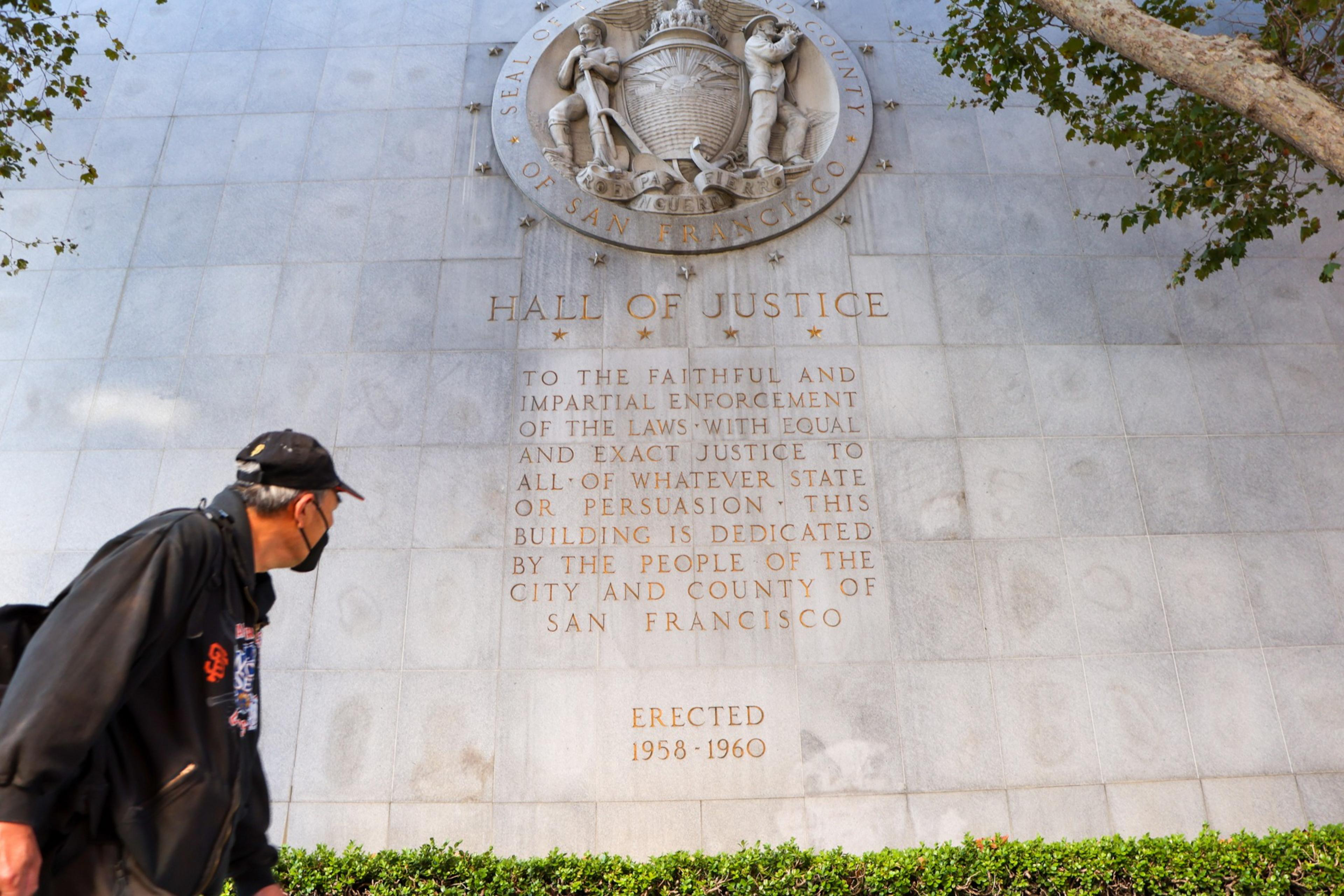Over seven months, Neil Peck became infamous among workers at Target at San Francisco’s Metreon mall.
Known as a “top offender” among the store’s asset protection workers, Peck allegedly went on a six-month shoplifting spree starting in November 2024, stealing more than $8,000 in merchandise over 17 occasions before being arrested in May 2025, according to court records.
The Target shoplifting spree was far from Peck’s first brush with California’s criminal justice system. The 49-year-old from Redding has racked up 24 criminal convictions since he was 17, eight of them for theft from CVS, Walgreens, and other stores. Yet an examination of his three-decade criminal history reveals a mind-numbing pattern of catch and release, in which Peck is let out of jail while his cases wend through the system, only to fail to appear in court when ordered, prompting his rearrest. He is ordered to accept mental health treatment while on probation but never does. He has never been to prison, according to state records.
Cases like Peck’s represent a “missing middle” in the criminal justice system, experts say, in which mentally ill, nonviolent offenders are referred to voluntary treatment that they abandon and end up cycling in and out of the criminal justice system.
Even as the San Francisco Police Department has reported a 27% drop (opens in new tab) in property crimes over the past year, individuals like Peck continue to place an outsize burden on the city’s law enforcement agencies, behavioral health facilities, and court systems, and pose the question of what can be done to stop the vicious cycle of chronic low-level offenders.
Peck’s most recent arrest occurred July 31, after he left a nine- to 12-month drug treatment program after just five days and did not appear in court as ordered, according to the San Francisco district attorney’s office. This was the 16th time he’d failed to appear in court, after being released from custody two dozen times in the course of seven criminal cases.
For his latest Target theft case, Peck pleaded guilty June 17 to two of 17 charges he faces: shoplifting with two or more priors and attempted grand theft, both felonies.

During the plea change hearing that day, judge Patrick Thompson said he intended to sentence Peck to two years of probation with ankle monitoring, order him to participate in a residential treatment program, and pay Target $7,848.86 in restitution. Should he fail in abiding by probation, Peck could face two years in jail.
After he was released and told to reappear for sentencing July 17, Peck was ordered to report to St. Anthony’s Father Alfred Center on 10th Street to enroll in residential drug treatment. Less than a week later, he ditched the program. A bench warrant was issued for his arrest, and he was booked into jail July 31.
‘That’s pretty much his pattern’
Peck entered the criminal justice system in 1993 at age 17, when he was convicted of lewd conduct in public, battery, and being a minor in possession of alcohol — all misdemeanors — in the Northern California fishing town of Crescent City.
His father, Roger Peck, attributed the pattern of theft and drug use to his son’s “inability to react in a social situation.”
Peck was diagnosed with attention deficit disorder around age 9 and would frequently forget what he was doing, his father said, losing focus while doing mundane tasks. He’d turn on the faucet to brush his teeth, then walk away and leave the water running “for hours.” He’d open the fridge and leave it ajar after wandering off. As a child and teenager, he’d skip class and was unable to concentrate in school.
“Anything with rules, he couldn’t follow,” Roger said. “He’d get a job and then lose it because he’d oversleep. He couldn’t concentrate.” Roger placed his son into residential mental health treatment programs: one in Utah for 12 months when he was 14, another in Spokane, Washington, the following year.
Peck dropped out of high school and ran away from his father’s home in Redding to Crescent City when he was 16, Roger said. Since then, he has had little contact with his family. During at least one previous arrest, Peck gave police his brother’s name, Kevin, as his own, according to his father. Other members of the Peck family could not be reached for comment.
Asked about Peck’s failures to appear in court, Roger was hardly surprised.
“That’s pretty much his pattern,” he said.

The last time Roger saw his son was in a San Francisco hospital around 2013. Peck had been admitted due to an infection in his leg from a syringe.
He still texts his father, often claiming to be in drug treatment.
“He’s been feeding me a line of shit for 15 years. He’s sober, not doing this or that,” Roger said. “He always reminisces about the times we’d go to the coast and catch clams and fish and [says] he’d love to do that. But that’s not going to happen.”
When diversion fails, then what?
Shoplifting and organized retail theft result in losses of billions of dollars a year for California businesses.
Rachel Michelin, president of the California Retailers Association, has called for harsher sentencing while stressing that mental health and drug issues should be addressed before sending people to prison. Asked how to deal with people who aren't willing to engage with diversion programs instead of jail, particularly if they are mentally ill, she admitted to being stumped.
“That’s the question being asked all around the state of California. How do you get people this help when, in California, you can’t force them into help?” she said. “It’s this catch-22.”
So what will it take to get Peck and other offenders to accept treatment, rather than face incarceration?
Political pressure to force mentally ill defendants into treatment has ramped up in recent years. San Francisco Board of Supervisors President Rafael Mandelman has long advocated for expanding conservatorships to force those with severe mental illness and substance use disorders into treatment, particularly if they are unable to recognize their condition.
“You wouldn’t ask a small child or someone with advanced dementia to make their own medical decisions,” he said.
He acknowledged that San Francisco lacks the funding, beds, and staff to conserve more people. The city needs to add between 100 and 140 beds for people held under conservatorships, according to a June presentation by Daniel Tsai, director of the Department of Public Health. Mayor Daniel Lurie has pledged to add 73 beds (opens in new tab).
Though conservatorships have grown more popular politically, some experts caution against their expense and restriction of civil liberties.
Alex V. Barnard, who published a 2023 book (opens in new tab) about California’s conservatorships, said the system is meant for people who are “gravely ill,” meaning they are too mentally ill or drug-addicted to provide for their basic needs of food and shelter.
To be placed under conservatorship, a person must first be put on a 5150 hold, admitted to the ER, and hospitalized for psychiatric care — often for several weeks. The hospital then refers the case to the county conservator, who reviews it and holds a hearing to determine eligibility. If approved, the person is sent to a facility equipped to treat mental illness or substance use — if a bed is available.
Even if more people qualified for conservatorships, there’s often nowhere to place them, according to Bernard. Psychiatric hospital stays cost the city about $1,000 per day; a stay in a locked facility typically costs $400-$500 daily, he said.
“It’s been described as a magic wand,” Bernard said. “It should be just for a very small segment of people.”
He said the only solution the California justice system has for mentally ill, nonviolent defendants is a carrot-and-stick approach in which they are referred to treatment, then face criminal sanctions if they don’t follow treatment plans.
“What do you do with someone who doesn’t engage with voluntary treatment but doesn’t meet the bar for conservatorships?” Barnard asked. “That’s what diversion is supposed to be, and it seems like it’s not working here.”

Another option, CARE Court, is unlikely to benefit a defendant like Peck, according to UC San Diego psychiatrist Aaron Meyer. CARE Court — which San Francisco launched in 2023 — is a civil court process that orders treatment for severely mentally ill people or those with severe drug addiction whose condition is deteriorating. Criminal defendants can be referred to it, but only if the judge believes they will benefit. Treatment ordered by CARE Court requires voluntary participation; given Peck’s long history of skipping court appearances and refusing court-ordered treatment, a petition on his behalf would almost certainly be rejected, Meyer said.
“The hope was CARE Court is the missing link,” he said. “But there are so many off-ramps.”
Andrea Crider, a staff attorney at UC Berkeley’s Criminal Law and Justice Center, said diversion programs are more effective than incarceration. But she noted that there are big holes in such programs, which are meant as alternatives to prison, particularly for people who are mentally ill.
“Traditional probation conditions are ineffective for people without the capacity to comply,” she said. “For people who don’t rise to the standard of conservatorship, there’s not a lot of middle ground for them to navigate their situation.”
That doesn’t leave many solutions beyond locking Peck behind bars.
Crider acknowledged that incarceration can help connect people to treatment, but jails and prisons are primarily concerned with monitoring inmates and ensuring they are taking medication prescribed while in custody.
Upon release, there are halfway houses, behavioral classes, and drug treatment available, but those resources are voluntary, and the staffers are often not trained in dealing with mental health issues, Crider said.
“One big failure is the continuum of care when they exit the system,” she said. “There’s no real reentry conditions set up if you don’t qualify for a conservatorship.”
Peck is scheduled to appear in court Tuesday to change his plea in the Target case. The DA’s office says it will ask the judge to sentence Peck to jail time. Whether that marks a turning point — or the start of another cycle — remains to be seen.
